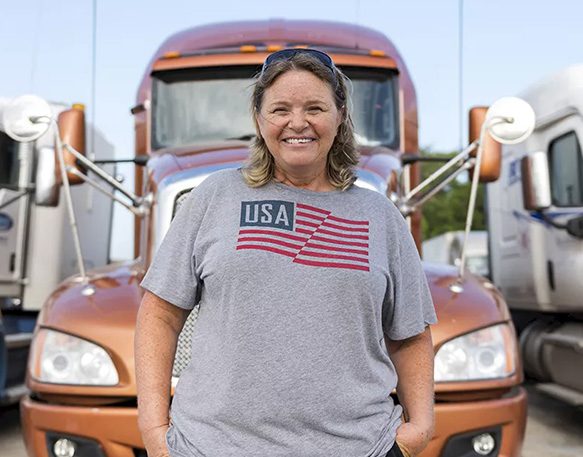In fact, according to the Occupational Safety and Health Administration (OSHA), delivery and truck driving is one of the most dangerous jobs in America.
Of course, driving is one of the most dangerous things the majority of the population does daily. But truck drivers still spend exponentially more time dealing with poor weather conditions, road hazards, and unpredictable drivers than the average motorist. That’s why industry experts place so much emphasis on trucking safety.
This guide will take you through top truck driver safety tips to create a handy truck driver safety checklist from the pros, ensuring that you’re trucking safely and effectively.
1. Stay compliant
Truck driver safety compliance is more than just a series of hoops drivers and companies must jump through to get on the road. Training, testing, and staying up to date on Federal Motor Carrier Act and Drug & Alcohol Clearinghouse rules is not a “nice to have” regarding truck driving safety–It’s mandatory. However, waiting on test results can often keep drivers off the road. Luckily, some great tools are out there, including DAT’s Driver Compliance, that can take the hassle out of drug and alcohol testing and workplace trucking safety training.
2. Make a maintenance schedule
Semi-trucks go through a lot of wear and tear on the road, so sticking to a regular maintenance schedule is one of the most essential truck driver safety tips. You should schedule basic, thorough, and full inspections regularly depending on how many miles you’ve driven recently.
Carriers and owner-operators should perform basic inspections every 15,000 miles. These assessments are crucial for trucking safety and include testing for brake and light functionality and checking and replacing fluids. A thorough inspection should come every 30,000 miles. These inspections will examine all aspects of a basic inspection but will also include changing lube and filters and any other emerging problems. Prevention is key.
Carriers and owner-operators should perform a full inspection annually to ensure a truck’s engine performs optimally. Addressing issues before they become more significant problems is at the top of any truck driver safety checklist because it not only prevents accidents, but regular maintenance also saves money in the long run.
3. Check the weather
Another critical aspect of trucking safety is knowing what you’re in for down the road. Be sure to check weather reports regularly for the entirety of your route. Conditions can change quickly, so keep an eye on the outside temperature while driving. Planning ahead for inclement weather and having a contingency plan for weather problems that can arise on the way can make it much easier to stay safely on schedule.
4. Take driving precautions
Truck driving is a complex and sometimes dangerous job. And too often, truck driving safety is compromised by difficult-to-maneuver situations. When delivering to a new location, always find a safe spot to park your rig and examine the delivery location on foot, taking care to make a mental note of hazards that might compromise trucking safety. Another way to avoid getting into a tight spot, especially in unfamiliar areas, is to pay extra attention at night and note fire hydrants, light posts, and ditches before leaving hard-to-navigate areas like truck stops.
There are also preventative measures you should take while on the road. While it can be frustrating to deal with inconsistent drivers constantly switching lanes and changing speeds all around you, staying in your lane will help keep you and other cars on the road safe. The odds of being in an accident increase every time a vehicle changes lanes. Picking a lane and staying in it means you are much less likely to be at fault if an accident does occur. Though lane changes do happen, changing carefully while checking blind spots and mirrors will make it much easier to avoid potential mishaps.
Finally, leaving room in front of your vehicle is also a crucial truck driver safety tip. Having a buffer zone between your rig and other drivers on the road will give you time to course correct and slow down should a dangerous situation arise. Most problems on the road will likely happen ahead of your truck, and a few extra seconds of decision-making time can make all the difference when it comes to trucking safety.
5. Stay focused
Driving long distances, especially on relatively empty stretches of road, can get a bit monotonous. The temptation to take a quick glance at a text message or maybe even send one yourself can be great. However, staying away from your phone is the top thing you can do to ensure trucking safety. According to the Federal Motor Carrier Safety Administration (FMCSA), “the odds of being involved in a crash, near-crash, or unintentional lane deviation are 23.2 times greater for truck and bus drivers texting while driving.” Taking your eyes off the road for even a few seconds makes it much more likely that drivers will be hazards on the road or accidentally drift into a dangerous situation.
In addition, truck drivers are only human, and humans get exhausted focusing on one task for long periods of time. Make sure that, just like with any job, you’re scheduling regular breaks. Use this time to stretch, regroup, check your load, tire pressure, and underneath your rig for any leaking coolant or oil.
6. Stock up
When it comes to truck driver safety tips, the common theme is thinking ahead, whether it’s two seconds down the road or days in the future. That’s why it is so important to ensure you are prepared for any situation that might arise while driving. Creating an emergency kit with basics such as a hard hat, road flares, protective eyewear, first aid supplies, and a flashlight will leave you better prepared to meet challenges as they arise. Beyond that, consider adding snacks, water, blankets, and a change of clothes to your emergency supplies in case you are forced to pull off the road and wait for assistance during unexpected situations that might arise in remote areas or during poor weather conditions.
7. Try trucker GPS tools
Plenty of great GPS tools are designed specifically to help truckers drive safely. A trucker’s GPS offers more features than a traditional GPS, including critical information about which exit to take and the distance before exits and advanced information like traffic patterns and alerts for when to change lanes. A word of caution: Truckers’ GPS is a great addition to your arsenal, but it shouldn’t be the only tool. Rely on your own judgment, weather reports, pre-planning, and even an old-fashioned analog map while figuring out the safest way to stay on schedule.
8. Slow down
And of course, at the top of every industry veteran’s truck driver safety checklist: stay in control by driving at a responsible speed. The more experience most truckers have with unpredictable drivers, unexpected changes in the weather, and unfamiliar terrain, the more most of those experts advocate for driving at safe speeds. Though time is always of the essence for truckers, being prepared, thinking ahead, and driving safely are much better ways to get the job done on time than endangering yourself and others by trying to travel quickly, instead of safely.
9. Find the right trucking safety tools with DAT
Since careful planning – from mapping routes to managing time – is such a critical aspect of trucker safety, any tool that can help simplify that planning can make a big difference. For carriers and owner-operators just starting out, tools like DAT Authority allow you to stay compliant and avoid delays while providing expert guidance every step of the way. Whether it’s getting your MC number, USDOT number, FMCSA registration, or more, DAT Authority helps you handle each requirement and regulation, cleaning up and streamlining your back office in the process.
The DAT Load Board is another tool that increases trucker safety through its many integrated features. For example, truckers can research the most convenient truck stops, gas stations, weight stations, or repair shops along their route to know where they can turn in case of emergencies. In addition, the DAT Load Board features more than 267 million loads posted annually, meaning that carriers and owner-operators can maximize their time on the road by finding the best loads with the best rates, and avoid any that might pose an unnecessary risk.
Ensure driver compliance with DAT partner CleanFleet
There’s nothing more important than trucker safety. DAT partner CleanFleet helps you keep your drivers – and everyone else on the road – safe and compliant with trustworthy drug testing and workforce training that meets every need. Get started with CleanFleet today!




